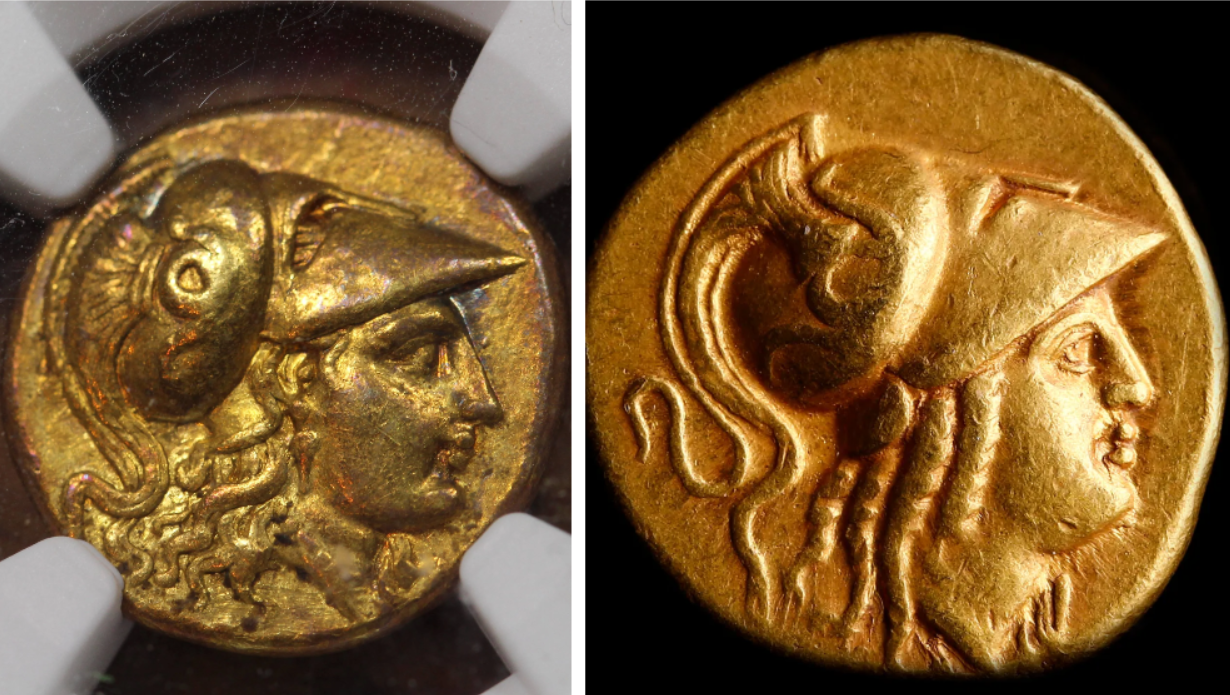Alexander the Great, one of history's most renowned conquerors, left a lasting legacy not only through his vast empire but also through his coinage. These coins played a pivotal role in unifying his diverse territories, spreading Hellenistic culture, and reinforcing his divine status and authority. Today, Alexander's coins are highly valued by collectors and historians alike, offering a tangible connection to the ancient world.
Types of Alexander the Great Coins: Alexander's coinage comprised various denominations, each with distinct imagery and purposes:
Gold Staters: These high-value coins typically depicted Athena on one side and Nike, the goddess of victory, on the other. Gold staters were used for significant transactions and as rewards for military service.
Silver Tetradrachms: Among the most common of Alexander's coins, tetradrachms featured Alexander as Heracles on one side and Zeus enthroned on the other. These coins facilitated larger everyday transactions and trade.
Drachms and Smaller Denominations: Used for daily transactions, these coins also featured similar iconography, reinforcing the visual representation of Alexander's power and divine favor.
Mint Locations and Production: To meet the demands of his expansive empire, Alexander established mints in numerous key locations, including:
Pella (Macedonia): The capital of Alexander's homeland.
Amphipolis: Another significant Macedonian mint.
Babylon: A major center in Mesopotamia.
Alexandria (Egypt): Founded by Alexander and a crucial cultural hub.
Tarsus (Cilicia): In modern-day Turkey, facilitating regional trade.
Quantities and Discoveries: Thousands of Alexander the Great coins have been discovered over the centuries through archaeological digs, hoards, and individual finds. These coins are housed in museums and private collections worldwide. Notable discoveries include:
The Aboukir Hoard (1902): Found in Egypt, containing over 7,000 coins, many from Alexander's era.
The Mesembria Hoard (1983): Discovered in Bulgaria, featuring a significant number of Alexander's coins.
Original and Modern Value: The value of these coins has evolved significantly from their original worth:
Gold Stater: Originally worth a soldier’s monthly pay, now valued between $3,000 and $20,000 or more depending on condition and rarity.
Silver Tetradrachm: Initially equating to a few days' wages for a skilled worker, currently priced between $200 and $2,000.
Drachms and Smaller Denominations: Once used for daily transactions, now ranging from $50 to $500.
Iconography and Significance: The imagery on Alexander's coins was meticulously chosen to convey his divine status and authority:
Heracles and Zeus: The frequent depiction of Heracles, with whom Alexander identified, emphasized strength and heroism. Zeus, the king of gods, reinforced Alexander's divine right to rule.
Inscriptions: Most coins bore the legend "AΛEΞANΔPOY" (of Alexander), a clear statement of his ownership and power.
Modern Collection and Authentication: Alexander the Great coins are highly sought after by collectors. Reputable dealers and auction houses ensure authenticity through rigorous processes, including:
Metallurgical Analysis: Examining the metal composition to verify origin.
Stylistic Comparison: Comparing designs to known genuine coins.
Provenance Research: Tracing the coin’s history to confirm legitimacy.
Notable Auctions: These coins frequently appear in numismatic auctions, where rare and well-preserved specimens can fetch high prices. Collectors prize them not only for their historical value but also for their connection to one of history's most iconic figures.
Alexander the Great's coins are more than just ancient currency; they are a testament to his expansive influence and enduring legacy. From their original use in ancient economies to their modern value in the collector's market, these coins offer a fascinating glimpse into the past and the power of coinage as a symbol of authority. Through their detailed imagery and widespread circulation, Alexander's coins continue to captivate and educate, preserving the memory of one of history's greatest conquerors.







